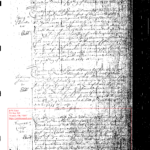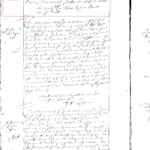First Pettits in America Series #1 –Richard Pettit; Virginia Immigrant in 1636
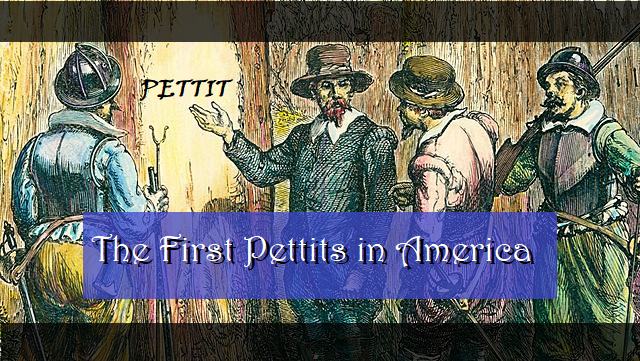
Richard Pettit aka Rich Pettit; Immigrant to James City County, VA in 1636. Related documents.
[NOTE: This is one of series of a articles created by The Pettit Research Project with the intent to identify and document various immigrants to American with the Pettit name.]
In 1636 Alexander Stomer (Stomar/Stoner) transported four people to the colony of Virginia. In exchange for this, he was granted 200 acres. (50 acres per head). Two of the people transported were servants and two were free. They were: Alice Curby, Richard Pettit (Pettitt), Robert Pitwell and Sampson Doubte. Stomer deeded this property to Samuel Curby on July 9, 1636.
Alice Curby was the wife of Samuel. Of the other three immigrants, it is not clear who were servants and who were free. It is possible Curby set up a small farm on this land and the servants worked there until they eared their freedom. It is also possible Curby had nothing to do with the transportation of anyone other than his wife.
Below are some related documents to these people.
On October 29, 1636, the deed of sale between Curby and Stomer was recorded. An abstract of this record appears on page 110 of the book “Cavaliers and Pioneers : A Calendar of Virginia Land Grants, 1623-1800; vol. 1, No. 1-6 by Nell Nugent” as seen below:
What appears to be an identical instrument this time listing immigrant names was filed the previous month on September 12, 1636, as seen on page 77 of Cavaliers and Pioneers:
The land involved was on “Tanks Pasby Hayes Creek”. The precises location of the land is obscured by the fact the place names have completely changed over the centuries. Thankfully, other references to this creek shed light on its location. On page 83 of Cavaliers and Pioneers, a man named Theodore Moyses purchased 2,000 acres of land around Tanks Pasbye Hayes Creek on May 23, 1637.
Evidently the name was changed shortly thereafter to reflect the owner. It became Moyses Creek.
From Moyses Creek the name was later changed again twice more. The historical marker for “Mt. Zion & Rustic” in Charles City Co, VA, says the following:
These communities were established on opposite banks of Morris Creek earlier known as Tanks Pasbye hayes the Indian name, Moyses Creek after Theodore Moyses who patented land there, and as Moses Creek. Before 1720 this area was part of James City County and Wallingford Parish.
“Tanks Pasby hayes Creek” mentioned in James City County, VA, therefore corresponds to modern day Morris Creek which enters into the Chickahominy River.
Note the proximity of this area to Jamestown. It is a distance of about 10-12 miles. It is hard to fathom, but in 1636 this area of eastern Virginia was the wild frontier.
Samuel Curby’s two original land deeds can be seen in the following links. The last page of the last deed lists Richard Pettit:
Though dates are given for when the land was granted, this is not necessarily the date of the arrival of Alice Curby and Richard Pettit to Virginia. It is possible they set foot on the Virginia shore weeks or months before July 9, 1636.
Alexander Stomer, who was credited with their transport, was a brickmaker who had land near a brick kiln on James Island in 1636. He also acquired land near the mouth of the Tanks Pasby Hayes Creek on a “clay bank” called “Old Trucking point” as recorded patent book I, p469. (It is interesting that in 1637 when this was mentioned, the point was already considered “old”.) He was involved in other land transactions and is mentioned as an adjacent property owner to William Davis in a May 4, 1639, land grant to Davis. Early Virginia Families Along the James River: Their Deep Roots and Tangled Branches, by Foley, Louise Pledge Heath. Vol. III, p15, abstracts one patent as such:
Stomer was a land speculator, brickmaker, and importer of people. It is possible he had no personal connection to Richard Pettit. It is equally possible Richard Pettit worked for him or Samuel Curby as either a free man or a servant. Generally speaking, under the laws of Virginia prior to 1640, most indentured servants were bound to their masters for 7 years.
After moving to Virginia, no further record of Richard Pettit has been found as of yet. By 1640 he would have been immersed in a colony that was firmly established with a population of about ten thousand people.
If you have any information on any of the people please leave a comment below.
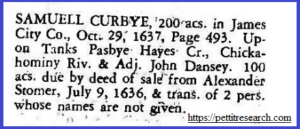
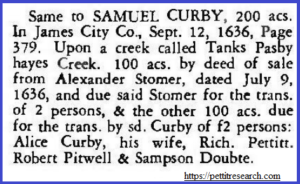
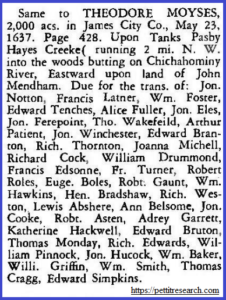
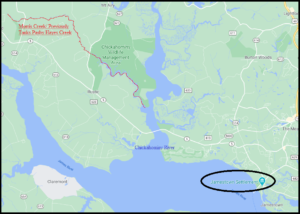
![Samuel Curby land grant, James City County, Virginia, July 9, 1636; Land Office Patents No. 1, 1623-1643 (v.1 & 2), p. 493 (Reel 1) [CLICK TO ENLARGE]](https://pettitresearch.com/familyhistory/wp-content/uploads/sites/3/2021/02/Samuel-Curby-land-deed-James-City-Co-VA-1636-150x150.png)
